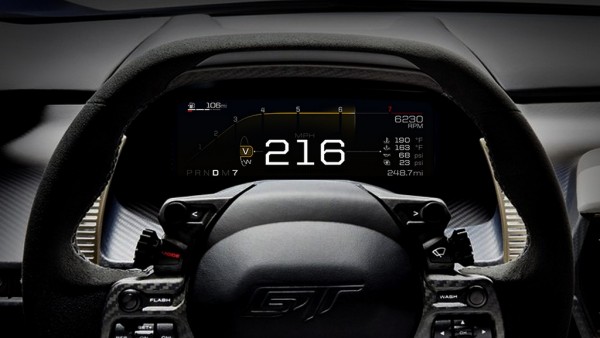It may come as a surprise to oldtimers, but these days a car’s instrument panel is a world unto its own with various modes and graphics and more computer power than the system that put a man on the moon. One of more complex instruments out there belongs to the new Ford GT which is why they have released a comprehensive guide on it.
Sitting behind the wheel of the new Ford GT you are greeted by a 10-inch wide digital gauge cluster which not that long ago would be considered an ideal sized PC monitor. This screen is adaptable to the car’s five different driving modes and configures itself to deliver the most relevant information for the given mode in an easy-to-read format, thus increasing driver’s comfort and reducing distraction while looking impeccably cool.
Ford GT Driving Modes in Detail:
- Normal mode displays information in a purposeful manner. The theme is simple; the speedometer is centered and bold, gear selection is to the right, fuel and temperature are top left. The hockey-stick-shaped tachometer displays in a compressed scale for lower rpm, as the engine revs so quickly the lower counts mean almost nothing to the driver. The 3,000-to-7,000-rpm range dominates the top of the display
- Wet mode carries many of the same information concepts over from normal mode, using a blue theme and a “wet floor” concept. Graphics under the speedometer emulate the shine of wet asphalt to remind the driver of the mode selection
- Sport mode adjusts information priorities. Front and centre is gear selection, with the speedometer off to the right and less prominent. It’s displayed in an orange theme and is the preferred mode for most test drivers
- Track mode presents a stark combination of black background and highly legible text and graphics, in a crisp, red theme that’s easy for the eye to pick up in a fast-paced environment. Gear selection and engine speed are displayed prominently, while coolant temperature, oil pressure, oil temperature and fuel level – rendered as a percentage rather than miles to empty – are bottom right
- V-Max offers an entirely different display – purposeful and pared down. Specifically tailored to pursuing maximum top speed, it displays a large, centered speedometer, with tachometer reduced to just a line with indicator dot for minimal distraction. Coolant temperature, oil pressure, oil temperature and turbocharger boost are displayed to the right, with fuel level displayed top left









